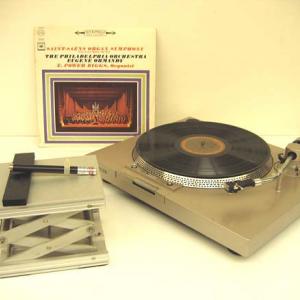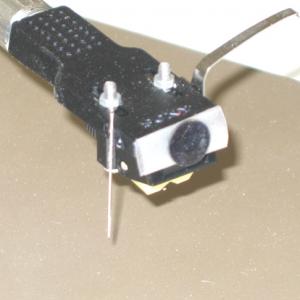College of Liberal Arts & Sciences
9B40.85 - Electron Microscope
Place the record on the turntable and place the needle on the section of the record that is marked. Turn on the laser pointer and reflect it off the arm onto a white screen or wall. As the needle sweeps over the loud and low note vibrations on the record, you will see the beam on the wall shake and vibrate, indicating those "electrons or atomic" regions.
- J. A. Panitz, Gertrude Rempfer, "A Transmission Electron Microscope for Lecture Demonstrations", AJP, Vol. 74, #11, Nov. 2006, p. 953.
- J. A. Panitz, "Contemporary Electronics:, A Focussed Concept Laboratory", AJP, Vol. 70, #3, March 2002, p. 280.
- Dieter G. Ast, "Optical Simulation of the Origin of Contrast in the Electron Microscope", AJP, Vol. 39, #10, Oct. 1971, p. 1164.
- M. P. Silverman, Wayne Strange, J. C. H. Spence, "The Brightest Beam in Science: New Directions in Electron Microscopy and Interferometry", AJP, Vol. 63, #9, Sept. 1995, p. 800.
- Mohammed Hassan, "Electron Microscopy for Attosecond Science", Physics Today, Vol. 77, #6, June 2024, p. 38.
- Yimei Zhu and Hermann Dürr, "The Future of Electron Microscopy", Physics Today, Vol. 68, Apr. 2015, p. 32.
- Sung Chang, "Walking a Silicon Atom Through a Graphene Landscape", Physics Today, Vol. 67, #9, Sept. 2014, p. 16.
- Ashley G. Smart, "A New Angle on Electron Microscopy", Physics Today, Vol. 67, #5, May 2014, p. 16.
- Barbara Goss Levi, "Focus on Improving Transmission Electron Microscopes Starts to Pay Off", Physics Today, Vol. 63, #6, June 2010, p. 15.
- Johanna Miller, "Casimir Forces Between Solids Can Be Repulsive", Physics Today, Vol. 62, #2, Feb. 2009, p. 19.
- Peter R. Buseck, "Electron Microscopy of Minerals", American Scientist, Vol. 71, #2, Mar/Apr. 1983, p. 175.
- T. Kallard, "Opitical Simulation of the Electron Microscope", Exploring Laser Light, p. 217 - 218.
- Curt Suplee, "Now You See It...", Everyday Science Explained, National Geographic, p. 100 - 101.
Disclaimer: These demonstrations are provided only for illustrative use by persons affiliated with The University of Iowa and only under the direction of a trained instructor or physicist. The University of Iowa is not responsible for demonstrations performed by those using their own equipment or who choose to use this reference material for their own purpose. The demonstrations included here are within the public domain and can be found in materials contained in libraries, bookstores, and through electronic sources. Performing all or any portion of any of these demonstrations, with or without revisions not depicted here entails inherent risks. These risks include, without limitation, bodily injury (and possibly death), including risks to health that may be temporary or permanent and that may exacerbate a pre-existing medical condition; and property loss or damage. Anyone performing any part of these demonstrations, even with revisions, knowingly and voluntarily assumes all risks associated with them.

